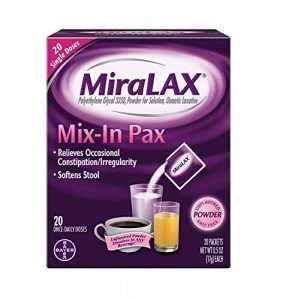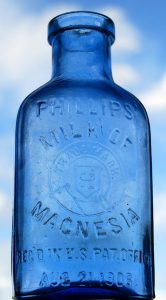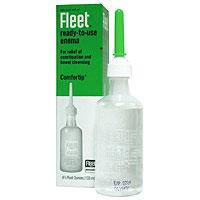7.4 Antidiarrheal Medications and Laxatives
Open Resources for Nursing (Open RN)
The digestive system is continually at work, but unless something goes amiss, you don’t notice your digestive system working. This section will focus on bowel disorders that occur in the lower intestine during the final step of digestion called defecation, when undigested materials are removed from the body as feces. During this final step, the large intestine absorbs water and changes the waste from liquid into stool; then peristalsis helps move the stool into the rectum. Diarrhea and constipation occur when conditions occur that affect this final step of defection.
The process of defecation begins when mass movements force feces from the colon into the rectum, stretching the rectal wall and provoking the defecation reflex, which eliminates feces from the rectum. This parasympathetic reflex is mediated by the spinal cord. It contracts the sigmoid colon and rectum, relaxes the internal anal sphincter, and initially contracts the external anal sphincter. Figure 7.9[1] reviews the anatomy of the rectum and its external and internal sphincters. The presence of feces in the anal canal sends a signal to the brain, which gives the person the choice of voluntarily opening the external anal sphincter (defecating) or keeping it temporarily closed. If defecation is delayed until a more convenient time, it takes a few seconds for the reflex contractions to stop and the rectal walls to relax. The next mass movement will trigger additional defecation reflexes until defecate occurs.[2]

If defecation is delayed for an extended time, additional water is absorbed, making the feces firmer and potentially leading to constipation. Alternatively, if the waste matter moves too quickly through the intestines, not enough water is absorbed, and diarrhea can result. Figure 7.10[3] demonstrates the Bristol Stool Chart that is used to assess stool characteristics ranging from very constipated to diarrhea.

You can further review how the digestive system works at the following links:
Digestive System Processes and Regulation
Your Digestive System and How it Works [4]
7.4a Antidiarrheals
Pathophysiology
Diarrhea is defined as the passage of three or more loose or liquid stools per day (or more frequent passage than is normal for the individual). Frequent passing of formed stools is not considered diarrhea. Diarrhea has multiple causes such as bacteria from contaminated food or water; viruses such as influenza, norovirus, or rotavirus; parasites found in contaminated food or water; medicines such as antibiotics, cancer drugs, and antacids that contain magnesium; food intolerances and sensitivities; and diseases that affect the colon, such as Crohn’s disease or irritable bowel syndrome.[6] The most severe threat posed by diarrhea is dehydration caused by the loss of water and electrolytes. Diarrheal disease is a leading cause of child mortality and morbidity throughout the world due to dehydration; frail elderly are also at risk. When severe diarrhea occurs, assessment for dehydration and electrolyte imbalances receive top priority and rehydration with oral rehydration solutions or IV fluids may be required.[7] Common medications used to manage the symptoms of diarrhea are discussed below.
Nursing Considerations
Assessment
When administering antidiarrheals, the nurse should document an abdominal assessment, frequency of bowel movements and stool characteristics, and if there is skin breakdown in the anal area. Dehydration is a serious risk in patients with severe diarrhea, so priority assessments and documentation relate to monitoring for dehydration, especially in vulnerable populations of infants, children, and elderly. If signs of dehydration occur, the provider should be immediately notified and treatment initiated for dehydration.
Implementation
Teach the patient to not exceed dosages of OTC medications because life-threatening adverse effects may occur. Probiotics have been found to be likely safe in all populations, and the nurse can advocate for the use of probiotics in patients with diarrhea or those at risk for diarrhea because of other medications prescribed. In addition to teaching about medication therapy, nurses can also teach patients with diarrhea other nonpharmacological interventions, such as replacing fluid and electrolytes by drinking water, sports drinks, or sodas without caffeine; and eating soft, bland food like bananas, rice, and toast. Children with severe diarrhea may also require oral rehydration solutions to replace lost fluids and electrolytes. The nurse should also keep in mind that antidiarrheals should be used very cautiously with children because some categories are contraindicated.
Evaluation
Because antidiarrheals treat the symptoms of diarrhea but do not eliminate the cause of it, if symptoms do not resolve within 48 hours, the provider should be notified and other potential causes of diarrhea investigated. Monitor for serious adverse effects such as increased bleeding in patients taking salicylates and for abnormal heart rhythms in patients taking loperamide and notify the provider immediately. Evaluation for dehydration should continuously occur until the condition resolves.
Antidiarrheal Medication Classes
There are three common mechanisms of action of antidiarrheal medications: adsorbents, which help eliminate the toxin or bacteria from the GI tract; antimotility agents, which slow peristalsis; and probiotics, which help to restore the normal bacteria found in the lower intestine. Oral rehydration agents may also be used in patients with diarrhea to replace fluid and electrolyte loss, but they do not treat the diarrhea. Antibacterial agents may also be used to treat diarrhea caused by specific infections, such as campylobacter or giardia, but they are not routinely needed.[8]
Adsorbents
Adsorption is the adhesion of molecules to a surface. This process differs from absorption, where a substance is dissolved or penetrates into a surface. Bismuth subsalicylate (brand name Pepto Bismol) is an example of an adsorbent (see Figure 7.11[9]).

Mechanism of Action Adsorbent medications work by coating the walls of the GI tract and binding the causative bacteria or toxin for elimination from the GI tract through the stool.[10]Bismuth subsalicylate also decreases the flow of fluids and electrolytes into the bowel, reducing inflammation within the intestine.[11]
Specific Administration Considerations Bismuth subsalicylate contains salicylate. It should be avoided if the patient has an allergy to salicylates (including aspirin) or if the patient is taking other salicylate products such as aspirin. It should not be used if the patient has an ulcer, a bleeding problem, or bloody or black stool. Children and teenagers who have or are recovering from chicken pox or flu-like symptoms should not use this product. When using this product, if changes in behavior with nausea and vomiting occur, consult a doctor because these symptoms could be an early sign of Reye’s syndrome, a rare but serious illness. Liquid products should be shaken well before use. Tablets should be swallowed whole and not chewed unless they are a chewable tablet. Medication can cause a black or darkened tongue. If symptoms worsen, a fever, or ringing in the ears occurs, or if diarrhea lasts longer than 48 hours, contact the provider. [12],[13]
Patient Teaching & Education
Patients should be advised to take medication as directed. They should be aware of potential color changes to stool that may occur and that the medication contains aspirin. They should discontinue the medication if tinnitus occurs.[14]
Antimotility
Antimotility medications help to treat diarrhea by slowing peristalsis. There are two categories of antimotility medication: anticholinergics and opiate-like medication.
Anticholinergics
Mechanism of Action Hyoscyamine is an anticholinergic that works on the smooth muscle of the GI tract to inhibit propulsive motility and decreases gastric acid secretion.
Specific Administration Considerations Read drug label information for all contraindications, including but not limited to, glaucoma, myasthenia gravis, and paralytic ileus. Diarrhea may be an early symptom of incomplete intestinal obstruction, and the use of this drug would be inappropriate and possibly harmful. CNS symptoms and other adverse effects may occur that are common with anticholinergic medications.[15],[16]
Patient Teaching & Education
Patients should receive instruction that these medications may cause dizziness and drowsiness. If patients experience dry mouth, frequent oral hygiene may alleviate discomfort.[17]
Opioid-like medication
Mechanism of Action Loperamide has an opioid-like chemical structure but causes fewer CNS effects. It works by decreasing the flow of fluids and electrolytes into the bowel and by slowing down the movement of the bowel to decrease the number of bowel movements (see Figure 7.12[18]).

Specific Administration Considerations Loperamide should not be given to a child younger than two years of age because of the risk of serious breathing and heart problems. Taking more than the prescribed dose can cause a serious abnormal heart rhythm that can lead to death. Read the drug label carefully for information about interaction with other medications, especially antidysrhythmics and antipsychotics.[19],[20]
Patient Teaching & Education
Patients should take medications as directed. They should also avoid alcohol and other CNS depressants. The medications may cause drowsiness.[21]
Probiotics
Probiotics are used for the prevention and treatment of diarrhea. They are often used concomitantly with antibiotics to prevent the common associated side effects of diarrhea (see Figure 7.13[22]). An example of a probiotic is lactobacillus.

Mechanism of Action Probiotics help replenish normal bacterial flora in the gastrointestinal tract.
Specific Administration Considerations/ Patient Teaching & Education Side effects of probiotics are mild such as gas and bloating. Probiotics are safe for use in children.[23],[24]
Now let’s take a closer look at medication grids comparing medications used to treat diarrhea. (See Table 7.4a[25],[26].)
Medication grids are intended to assist students to learn key points about each medication. Because information about medication is constantly changing, nurses should always consult evidence-based resources to review current recommendations before administering specific medication. Basic information related to each class of medication is outlined below. Detailed information on a specific medication can be found for free at Daily Med. On the home page, enter the drug name in the search bar to read more about the medication. Prototype/generic medications listed in the grids below are also hyperlinked directly to a Daily Med page.
Table 7.4a Comparison of Medications Used to Treat Diarrhea
Class |
Prototype/Generic |
Administration Considerations |
Therapeutic Effects |
Adverse/Side Effects |
|---|---|---|---|---|
| Adsorbents | bismuth subsalicylate (Pepto Bismol) | Avoid if taking other salicylates
Do not use in children or teenagers recovering from chicken pox or flu-like symptoms as may cause Reye’s syndrome Do not use if patient has an ulcer, bleeding problem, or bloody or black stool |
Decreased diarrhea symptoms | May cause black or darkened tongue
Contact provider if symptoms worsen, a fever, or ringing in the ears occurs, or if diarrhea lasts longer than 48 hours |
| Anticholinergic | hyoscyamine | Contraindicated in glaucoma, myasthenia gravis, or paralytic ileus | Decreased diarrhea symptoms | May cause CNS and other adverse effects associated with anticholinergic medication |
| Opiate-like medication | loperamide (lmodium) | Contraindicated in children younger than 2 and with several other medications; read drug label information before administering | Decreased diarrhea symptoms | Black Box Warning: May cause abnormal heart rhythm |
| Probiotics | lactobacillus | Pediatric dosing is age based and varies by product | Prevention of diarrhea or decreased symptoms of diarrhea | Mild such as gas and bloating |
Critical Thinking Activity 7.4a 
- A patient has been prescribed loperamide for diarrhea associated with gastroenteritis. The patient begins to complain of “heart palpitations.” What is the nurse’s next best response?
- A child, aged 6, has diarrhea. The mother asks the nurse what OTC medications she can provide to her child to help resolve the diarrhea. What is the nurse’s best response?
Note: Answers to the Critical Thinking activities can be found in the “Answer Key” sections at the end of the book.
7.4.b Constipation
Pathophysiology
Constipation is defined as “three or fewer bowel movements in a week; stools that are hard, dry or lumpy; stools that are difficult or painful to pass; or the feeling that not all stool has passed.”[27] If defecation is delayed for an extended time, additional water is absorbed, thus making the feces firmer and potentially leading to constipation. There are several causes of constipation, such as lack of proper fluids or fiber in the diet, lack of ambulation, various disease processes, recovery from surgical anesthesia and opiates, and side effects of many medications. A list of these potential causes can be found in Figure 7.6.[28] Because there are several potential causes of constipation, treatment should always be individualized to the patient. Many times, constipation can be treated with simple changes in diet, exercise, or routine. However, when medications are also needed to resolve constipation, there are several categories of laxative medications that work in different ways. Classes of laxative medications are described below.
Figure 7.6 Common Causes of Constipation
| Medications | Antacids that contain aluminum and calcium
Anticholinergics and antispasmodics Anticonvulsants—used to prevent seizures Calcium channel blockers Diuretics Iron supplements Medicines used to treat Parkinson’s disease Narcotic pain medicines Some medicines used to treat depression |
|---|---|
| Health and Nutrition Problems | Not eating enough fiber
Not drinking enough liquids or dehydration Not getting enough physical activity Celiac disease Disorders that affect the brain and spine, such as Parkinson’s disease Spinal cord or brain injuries Diabetes Hypothyroidism Inflammation linked to diverticular disease or proctitis Intestinal obstructions, including anorectal blockage and tumors |
| Daily Routine Changes | Pregnancy
Aging Traveling Ignoring the urge to have a bowel movement Medication changes Change in diet |
Nursing Considerations
Assessment
The nurse should assess for the potential cause of the patient’s constipation and appropriately individualize the treatment and patient education. The nurse should document an abdominal assessment that includes discomfort, distention, and decreased bowel sounds. The date of the last bowel movement should also be documented. The patient may be asked additional history questions such as the appearance of the stool to determine if it is hard and dry, if passing the stool is difficult or painful, or if there is a feeling of incomplete emptying.
Implementation
Many facilities have a bowel medication protocol with progressive treatment of constipation ranging from stool softeners to stimulants to enemas, depending on the length of time since the last bowel movement. Medications should be administered according to label instructions, and the patient should be instructed when to expect a bowel movement will occur. Measures to prevent constipation should also be discussed with the patient.
Patient teaching for all classes of laxative medications should be individualized based on the cause of constipation. Measures to prevent constipation should be reviewed with the patient, such as:
- Getting enough fiber in the diet
- Drinking plenty of water and other liquids
- Getting regular physical activity
- Trying to have a bowel movement at the same time every day[29]
Evaluation
If a bowel movement does not occur within the expected timeframe, the provider should be notified and other causes investigated for individualized treatment. It is imperative that good documentation of bowel movements and communication among staff occur when constipation is being treated with various medications. If there is a complete absence of bowel sounds, worsening distension or abdominal pain, a smearing of stool, or other findings indicating that a paralytic ileus or blockage may be occurring, the provider should be immediately notified.
Laxative Classes
There are five categories of laxative medications commonly used to treat constipation: fiber supplements, stool softeners, osmotic agent, lubricants, and stimulants (See Table 7.4b.1). Fiber supplements and stool softeners are often used daily to prevent constipation, whereas the other laxative categories are used to treat constipation. Table 7.4b1 compares the mechanism of action for each laxative category and includes common prototype and OTC brand names.[30],[31],[32]
Table 7.4b1 Categories of Laxatives Used to Treat Constipation
Category |
Prototypes |
Mechanism of Action |
|---|---|---|
| Fiber supplements | psyllium (Metamucil) | Bulk forming to facilitate passage of stool through rectum |
| Stool softeners | Docusate (Colace) | Facilitates movement of water and fats into stool |
| Osmotic agents | Milk of Magnesia; polyethylene glycol (PEG) 3350 (Miralax) | Causes water to be retained with the stool, increasing the number of bowel movements and softening the stool so it is easier to pass |
| Lubricants | mineral oil enema (Fleet) | Coats the stool to help seal in water |
| Stimulants | Bisacodyl (Dulcolax) | Causes the intestines to contract, inducing stool to move through the colon |
Fiber supplements
Psyllium (brand name Metamucil) is an example of a common OTC fiber supplement (see Figure 7.14[33]).

Mechanism of Action Psyllium adds bulk to the stool to facilitate passage through the rectum.
Specific Administration Considerations When administering, put one dose into an empty glass and mix with at least 8 ounces of water or other fluid. Taking this product without enough liquid may cause choking. Stir briskly and drink promptly. If mixture thickens, add more liquid and stir. Administer at least 2 hours before or 2 hours after other medications as it can affect absorption. Psyllium usually produces a bowel movement within 12 to 72 hours. It may cause bloating and cramping.
Patient Teaching & Education When teaching patients how to take psyllium at home, in addition to the above considerations, advise them to start with 1 dose per day but may gradually increase to 3 doses per day as necessary to maintain soft stools.
Stool Softeners
Docusate is a common OTC stool softener that is also used frequently in health care settings.
Mechanism of Action: Docusate facilitates movement of water and fats into stool to make it soft and improve regularity of bowel movements.
Specific Administration Considerations: Docusate usually produces a bowel movement in 12 to 72 hours. It may cause stomach cramping.
Osmotic Agents
Milk of Magnesia and polyethylene glycol 3350 (brand name Miralax) are examples of common osmotic agents used to promote a bowel movement (see figure 7.15[34].


Mechanism of Action Osmotic agents cause water to be retained with the stool, increasing the number of bowel movements and softening the stool so it is easier to pass.
Specific Administration Considerations Polyethylene glycol 3350 has a bottle top that can be used as a measuring cap to contain 17 grams of powder when filled to the indicated line. Fill to top of clear section in cap, which is marked to indicate the correct dose (17 g); stir and dissolve in any 4 to 8 ounces of beverage (cold, hot or room temperature), and then administer.
Patient Teaching & Education In addition to the administration considerations above, teach patients that polyethylene glycol usually produces a bowel movement in 1-3 days. It may cause loose, watery stools.
Lubricants
A mineral oil enema (brand name Fleet enema) is an example of a lubricant laxative (see Figure 7.16[35]).

Mechanism of Action Mineral oil coats the stool to help seal in water.
Specific Administration Considerations Read drug label for children as some brands can be used in children aged 2 or older, whereas others are not intended for children.
Patient Teaching & Education A mineral oil enema generally produces a bowel movement in 2 to 15 minutes. It may cause stomach cramps, bloating, upset stomach, or diarrhea.
Stimulants
Bisacodyl is an example of a stimulant laxative.
Mechanism of Action Bisacodyl causes the intestines to contract, inducing the stool to move through the colon.
Specific Administration Considerations Oral dosage or rectal suppositories are available. See instructions for how to insert a rectal suppository. Instruct patient to retain suppository for about 15 to 20 minutes (see Figure 7.17[36]).

Patient Teaching & Education A bowel movement is generally produced in 15 minutes. Bisacodyl may cause stomach cramps, dizziness, or rectal burning.
Now let’s take a closer look at the medication grids comparing medications used to treat constipation. (See Table 7.4b2).[37],[38]
Medication grids are intended to assist students to learn key points about each medication. Because information about medication is constantly changing, nurses should always consult evidence-based resources to review current recommendations before administering specific medication. Basic information related to each class of medication is outlined below. Detailed information on a specific medication can be found for free at Daily Med. On the home page, enter the drug name in the search bar to read more about the medication. Prototype/generic medications listed in the grids below are also hyperlinked directly to a Daily Med page.
Table 7.4b2 Medication Grid Comparing Laxatives Used to Treat Constipation
| Prototype/Generic | Administration Considerations | Therapeutic Effects | Adverse/Side Effects |
|---|---|---|---|
| psyllium (Metamucil) | Put one dose into an empty glass and mix with at least 8 ounces of water or other fluid. Taking this product without enough liquid may cause choking. Stir briskly and drink promptly. If mixture thickens, add more liquid and stir
Usually produces a bowel movement within 12 to 72 hours Administer at least 2 hours before or 2 hours after other medications as it can affect absorption Start with 1 dose per day; may gradually increase to 3 doses per day as necessary |
Improves regularity of bowel movements | May cause bloating and cramping |
| docusate | Usually produces bowel movement in 12 to 72 hours | Softens stool and improves regularity of bowel movements | May cause abdominal cramping |
| polyethylene glycol 3350 (Miralax) | Usually produces a bowel movement in 1-3 days
The bottle top is a measuring cap marked to contain 17 grams of powder when filled to the indicated line For adults and children 17 years of age and older: ○ fill to top of clear section in cap, which is marked to indicate the correct dose (17 g) ○ stir and dissolve in any 4 to 8 ounces of beverage (cold, hot or room temperature) and then drink ○ use once a day ○ use no more than 7 days |
Softens stool and improves regularity of bowel movements | May cause loose, watery stools |
| Mineral oil enema | Read drug label for children as some brands can be used in children aged 2 or older, whereas others are not intended for children
Generally produces bowel movement in 2 to 15 minutes |
Bowel movement within 15 minutes | Stomach cramps, bloating, upset stomach, or diarrhea |
| bisacodyl | Oral dosage or rectal suppositories are available
To administer a rectal suppository: Position patient on left side with the right knee up towards the chest. In the presence of anal fissures or hemorrhoids, suppositories should be coated at the tip with petroleum jelly. Remove foil and insert suppository well into rectum touching the bowel wall. Instruct patient to retain suppository for about 15 to 20 minutes. A bowel movement is generally produced in 15 minutes to one hour. For children, read drug label for dosage |
Bowel movement within one hour | Stomach cramps, dizziness, or rectal burning |
Interactive Activity
Critical Thinking Activity 7.4b 
A patient who underwent hip surgery two days ago has not had a bowel movement since before admission. The patient is receiving oxycontin ER 10 mg every 12 hours and oxycodone 5 mg every 4 hours for pain. The patient describes abdominal discomfort and the nurse finds decreased bowel sounds in all quadrants. The nurse notifies the physician, follows the bowel protocol, and administers docusate sodium to the patient.
- What are the potential causes of constipation that should be addressed for this patient?
- What is the mechanism of action for docusate?
- The patient asks how quickly the medication will work. What is the nurse’s best response?
- What other preventative measures for constipation should the nurse teach the patient?
- If docusate is not effective within 24 hours, what other medications can the nurse anticipate to be ordered?
Note: Answers to the Critical Thinking activities can be found in the “Answer Key” sections at the end of the book.
- "Anorectum.gif" by U.S. Government National Institutes of Health is licensed under CC0 ↵
- This work is a derivative of Anatomy and Physiology by OpenStax licensed under CC BY 4.0. Access for free at https://openstax.org/books/anatomy-and-physiology/pages/1-introduction ↵
- "BristolStoolChart.png" by Cabot Health, Bristol Stool Chart is licensed under CC BY-SA 3.0 ↵
- National Institute of Diabetes and Digestive and Kidney Diseases, National Institute of Health. (2018). Treatment for constipation.https://www.niddk.nih.gov/health-information/digestive-diseases/constipation/treatment. ↵
- Digesting Food by Stanford School of Medicine and Khan Academy is licensed under CC BY-NC-SA 3.0. ↵
- A.D.A.M. Medical Encyclopedia [Internet]. Atlanta (GA): A.D.A.M., Inc.; ©2019. Heartburn; [reviewed 2019 May 10; cited 2019 October 27]. https://medlineplus.gov/ency/anatomyvideos/000068.htm ↵
- World Health Organization. (2017, May 2). Diarrhoeal disease.https://www.who.int/en/news-room/fact-sheets/detail/diarrhoeal-disease. ↵
- World Health Organization. (2017, May 2). Diarrhoeal disease.https://www.who.int/en/news-room/fact-sheets/detail/diarrhoeal-disease ↵
- "PeptoBismol Bottle.JPG" by ParentingPatch is licensed under CC BY-SA 3.0 ↵
- Lilley, L., Collins, S., & Snyder, J. (2014). Pharmacology and the Nursing Process. pp. 782-862. Elsevier. ↵
- A.D.A.M. Medical Encyclopedia [Internet]. Atlanta (GA): A.D.A.M., Inc.; ©2019. Heartburn; [reviewed 2019 May 10; cited 2019 October 27]. https://medlineplus.gov/ency/anatomyvideos/000068.htm ↵
- This work is a derivative of Daily Med by U.S. National Library of Medicine in the public domain. ↵
- A.D.A.M. Medical Encyclopedia [Internet]. A.D.A.M. Medical Encyclopedia [Internet]. Atlanta (GA): A.D.A.M., Inc.; ©2019. Heartburn; [reviewed 2019 May 10; cited 2019 October 27]. https://medlineplus.gov/ency/anatomyvideos/000068.htm ↵
- uCentral from Unbound Medicine. https://www.unboundmedicine.com/ucentral ↵
- This work is a derivative of Daily Med by U.S. National Library of Medicine in the public domain. ↵
- A.D.A.M. Medical Encyclopedia [Internet]. Atlanta (GA): A.D.A.M., Inc.; ©2019. Heartburn; [reviewed 2019 May 10; cited 2019 October 27]. https://medlineplus.gov/ency/anatomyvideos/000068.htm ↵
- uCentral from Unbound Medicine. https://www.unboundmedicine.com/ucentral ↵
- "Loperamide2mg.JPG" by Kristoferb is licensed under CC BY-SA 3.0 ↵
- This work is a derivative of Daily Med by U.S. National Library of Medicine in the public domain. ↵
- A.D.A.M. Medical Encyclopedia [Internet]. Atlanta (GA): A.D.A.M., Inc.; ©2019. Heartburn; [reviewed 2019 May 10; cited 2019 October 27]. https://medlineplus.gov/ency/anatomyvideos/000068.htm ↵
- uCentral from Unbound Medicine. https://www.unboundmedicine.com/ucentral ↵
- "WildWood Probiotic Soyogurt" by Veganbaking.net is licensed under CC BY-SA 2.0 ↵
- This work is a derivative of Daily Med by U.S. National Library of Medicine in the public domain. ↵
- A.D.A.M. Medical Encyclopedia [Internet]. Atlanta (GA): A.D.A.M., Inc.; ©2019. Heartburn; [reviewed 2019 May 10; cited 2019 October 27]. https://medlineplus.gov/ency/anatomyvideos/000068.htm ↵
- This work is a derivative of Daily Med by U.S. National Library of Medicine in the public domain. ↵
- A.D.A.M. Medical Encyclopedia [Internet]. Atlanta (GA): A.D.A.M., Inc.; ©2019. Heartburn; [reviewed 2019 May 10; cited 2019 October 27]. https://medlineplus.gov/ency/anatomyvideos/000068.htm ↵
- National Institute of Diabetes and Digestive and Kidney Diseases, National Institute of Health. (2018). Symptoms and causes of constipation.https://www.niddk.nih.gov/health-information/digestive-diseases/constipation/symptoms-causes ↵
- National Institute of Diabetes and Digestive and Kidney Diseases, National Institute of Health. (2018). Symptoms and causes of constipation.https://www.niddk.nih.gov/health-information/digestive-diseases/constipation/symptoms-causes ↵
- National Institute of Diabetes and Digestive and Kidney Diseases, National Institute of Health. (2018). Treatment for constipation. https://www.niddk.nih.gov/health-information/digestive-diseases/constipation/treatment ↵
- This work is a derivative of Daily Med by U.S. National Library of Medicine in the public domain. ↵
- National Institute of Diabetes and Digestive and Kidney Diseases, National Institute of Health. (2018). Treatment for constipation. https://www.niddk.nih.gov/health-information/digestive-diseases/constipation/treatment. ↵
- Drugs.com [Internet]. Fleet mineral oil enema (rectal); © 1996-2018 [updated 1 October 2019; cited 27 October 2019]. https://www.drugs.com/mtm/fleet-mineral-oil-enema-rectal.html ↵
- "Metamucil ad (cropped).jpg" by unknown is licensed under CC0 ↵
- "MiraLax Mix-In Pax, Unflavored, 20 Little Packets" by Ava Williams is licensed under CC0 and "Phillips' Milk of Magnesia, 1910's" by Roadsidepictures is licensed under CC BY-NC 2.0 ↵
- "fleet_enema" by Logesh79 is licensed under CC BY-NC 2.0 ↵
- "Administering-med-rectally-2.png" by British Columbia Institute of Technology (BCIT) is licensed under CC BY 4.0 ↵
- This work is a derivative of Daily Med by U.S. National Library of Medicine in the public domain. ↵
- Drugs.com [Internet]. Metamucil; © 2000-2019 [reviewed 20 November 2017; updated 1 October 2019; cited 27 October 2019]. https://www.drugs.com/mtm/metamucil.html ↵
The digestive process where undigested materials are removed from the body as feces.
The passage of three or more loose or liquid stools per day (or more frequent passage than is normal for the individual).
Relieve the symptoms of diarrhea, such as an increased frequency and urgency when passing stools, but do not eliminate the cause of it.
Medications that help to treat diarrhea by slowing peristalsis.
The adhesion of molecules to a surface. For example, bismuth salicylate coats the walls of the GI tract and binds the causative bacteria or toxin for elimination from the GI tract through the stool.
Laxatives that facilitate movement of water and fats into stool to make it soft and improve regularity of bowel movements.
Cause water to be retained with the stool, increasing the number of bowel movements and softening the stool so it is easier to pass.
Laxatives that cause the intestines to contract, inducing stool to move through the colon.

